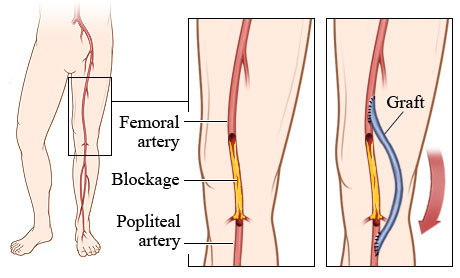What you need to know about Femoropopliteal and Femorotibial Bypass Graft Surgery
Contents
- 1 What you need to know about Femoropopliteal and Femorotibial Bypass Graft Surgery
- 2 What does the Procedure Involve?
- 3 How Long Should I Stay in the Area?
- 4 What’s the Recovery Time?
- 5 What About Aftercare?
- 6 What’s the Success Rate?
- 7 Are there Alternatives to Femoropopliteal and Femorotibial Bypass Graft Surgery?
- 8 What Should You Expect Before and After the Procedure
Femoropopliteal and Femorotibial bypass graft surgery are procedures that are used to treat femoral artery disease. They are carried out to bypass the diseased portion of the main artery in the leg using a piece of a healthy blood vessel. The goal of both surgeries is to restore blood flow and relieve intermittent claudication.
Femoropopliteal bypass graft surgery (also known as femoropopliteal or Fem-Pop) is a procedure that is performed to bypass narrowed or blocked blood vessels below or above the knee. This procedure is usually performed to treat conditions that affect circulation, such as peripheral arterial disease/peripheral vascular disease or intermittent claudication.
Femorotibial bypass surgery (also called infra-popliteal reconstruction) is a procedure that is performed to bypass narrowed or blocked blood vessels in the lower leg or foot. The procedure is used for patients with blocked or narrowed tibial or peroneal arteries.
Doctors usually recommend femoropopliteal and femorotibial bypass graft surgery for the following reasons:
-
Disability-interference with ability to work or quality of life
-
Other types of treatment have not improved symptoms
-
Infection, gangrene, or non-healing wounds
-
The danger of loss of limb because of decreased blood flow
-
Intermittent claudication or pain that is felt while resting.

What does the Procedure Involve?
The procedures for femoropopliteal and femorotibial bypass surgery can vary depending on your specific condition and your doctor’s practices.
In general, you will have to lie on your back on the operating table during femoropopliteal and femorotibial bypass surgery. Then, your surgical team may shave the surgical site if there is too much hair. You will then be given local or general anesthesia. With local anesthesia, you will be awake but will not be able to feel the area operated on. With general anesthesia, you will be asleep throughout the procedure.
Once you are anesthetized, your surgeon will clean the skin over the surgical site. An incision will then be created in the leg. The location of the incision depends on the section of the arteries to be bypassed. In femoropopliteal bypass surgery, the incision will be made above or under the knee, but in femorotibial bypass surgery, the incision will be made around the lower leg or foot.
Your surgeon will determine whether to use a healthy blood vessel from your leg or man-made graft material. Wherever possible, your surgeon will use an existing piece of a healthy vein from your leg because, while effective, man-made graft materials are more likely to become narrowed again.
In femoropopliteal bypass graft surgery, your doctor stitches the healthy vein or man-made graft onto both the femoral and popliteal so that blood can travel through the new vessel, around the blocked or narrowed area. In femorotibial bypass graft surgery, your doctor stitches the healthy vein or man-made onto the small vessels of the foot or lower leg.
After the graft has successfully attached to the diseased artery, your surgeon may perform an arteriogram to confirm that blood flow has been restored. Then, the incision will be stitched together.
How Long Should I Stay in the Area?
You may need to stay in the hospital 2 to 5 days after femoropopliteal and femorotibial bypass graft surgery. It is a good idea to stay in the area for at least 7 to 14 days for initial recovery, especially since you may have some pain from the incision for about a week. Besides, you also need to attend a follow-up checkup where your doctor monitors your condition and remove the stitches.
What’s the Recovery Time?
The full recovery time may take around 6 to 12 weeks. During this period, you should avoid any strenuous activities, including intense workout and heavy lifting. Depending on the type of work you do and the way you feel, you should be able to go back to work and some normal activities within 3 to 6 weeks following the surgery.
What About Aftercare?
Your medical team will give you aftercare instructions. You need to keep the surgical area clean and dry and avoid having a bath for at least two weeks. Make sure to drink plenty of fluid (unless your surgeon tells you not to) and take the medicines your doctor prescribed as directed. You may need to attend regular checkups with your local doctor to ensure that the new graft is working.
What’s the Success Rate?
Femoropopliteal and Femoro-tibial bypass graft surgery are safe and effective. A vein bypass in the leg can last five years or more in about 70% of patients. While the procedure is very safe, some risks and side effects can occur. These include, but are not limited to:
-
Bleeding
-
Infection from the incision
-
Stroke or heart attack
-
Failed or blocked grafts
-
Leg swelling.
Are there Alternatives to Femoropopliteal and Femorotibial Bypass Graft Surgery?
The alternatives to femoropopliteal and femorotibial bypass graft surgery include:
-
Percutaneous Transluminal Angioplasty (PTA) – this procedure involves the insertion of a thin tube with a tiny balloon at its end into a blood vessel. When the tube arrived at the narrowed vein, your doctor inflates the balloon to push the plaque outward, which widens the artery.
-
Stenting – this procedure involves the insertion of a stent (a small, metal mesh tube) that can keep the narrowed blood vessel open. The stent is left in place to keep the vessel open.
What Should You Expect Before and After the Procedure
Before femoropopliteal and femorotibial bypass graft surgery, you may experience symptoms that may interfere with your ability to perform daily activities and/or will not get better with other treatment methods caused by a blocked or narrowed blood vessel in your leg or foot. After the procedure, these symptoms should be relieved, blood flow should be restored, and you should be able to enjoy your daily activities without any pain.
For an in-depth analysis of a Femoropopliteal and Femorotibial Bypass Graft Surgery Procedure, watch this short video.
To check prices or to book a Femoropopliteal and Femorotibial Bypass Graft Surgery Procedure, in Thailand or anywhere else in the world, head on over to MyMediTravel now!

